
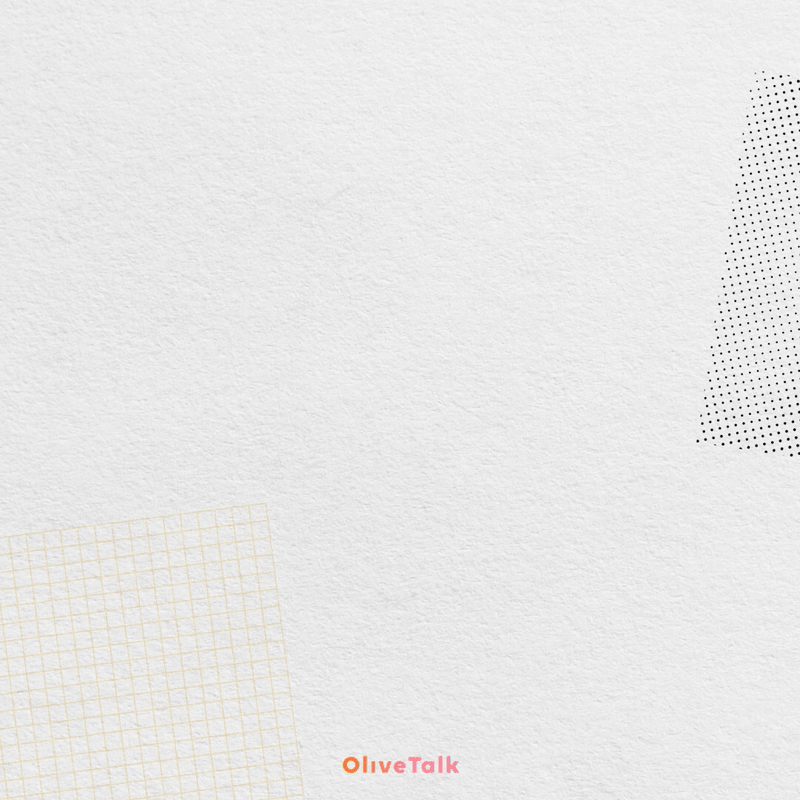
💧 What is Panthenol?
Panthenol is the alcohol analog of pantothenic acid (vitamin B5) a water-soluble humectant and skin-conditioning agent with potent soothing, repairing, and hydrating properties. In skincare, it’s known as Provitamin B5, because once absorbed, it converts to pantothenic acid in the skin and hair.
Structurally, panthenol is 1)Hygroscopic (draws and retains moisture), 2)pH balanced for skin compatibility, 3)Well-tolerated by all skin types, including infants and post-procedure skin, 4)Available in two isomeric forms: D- and DL-panthenol (D-form is biologically active)
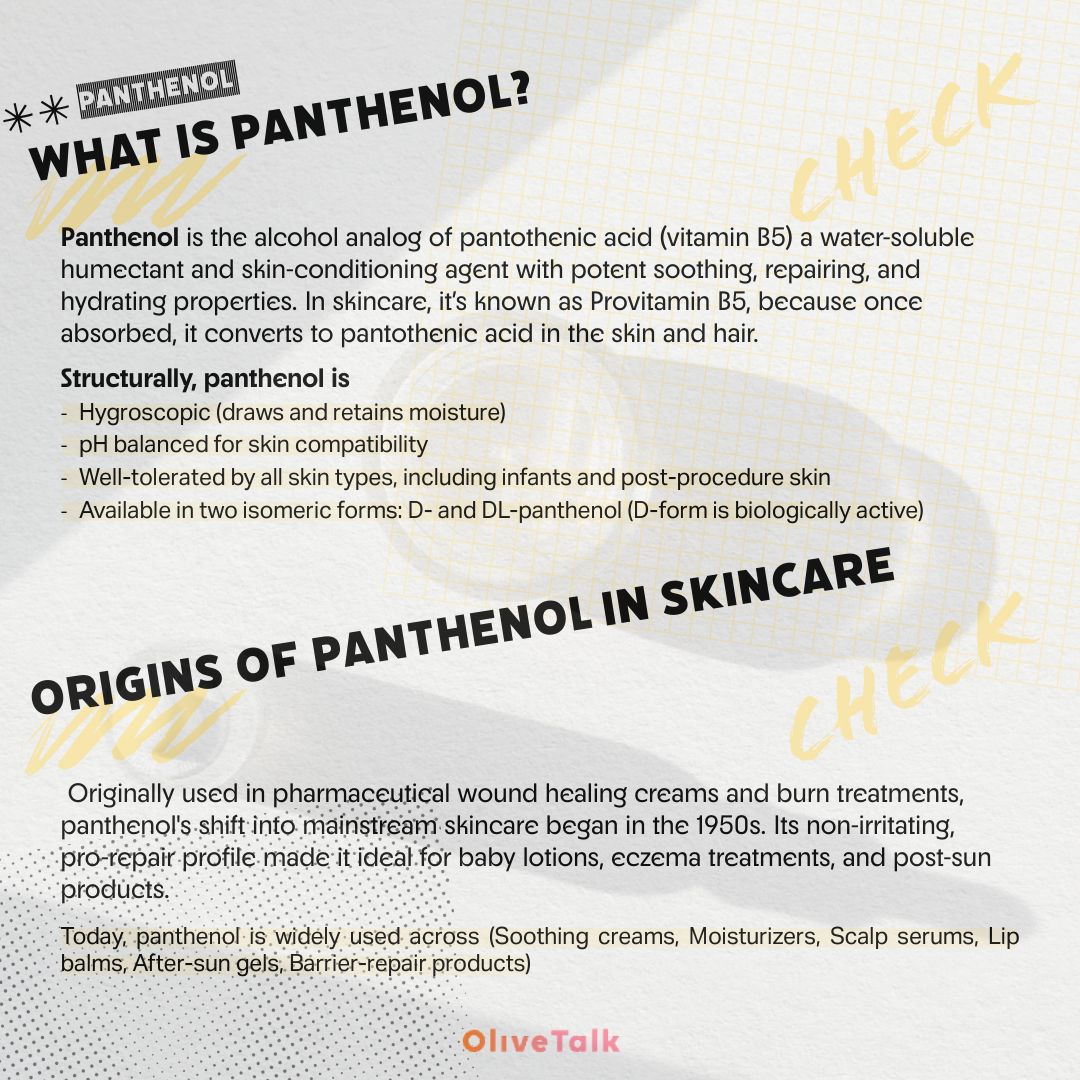
🌱 Origins of Panthenol in Skincare
Originally used in pharmaceutical wound healing creams and burn treatments, panthenol's shift into mainstream skincare began in the 1950s. Its non-irritating, pro-repair profile made it ideal for baby lotions, eczema treatments, and post-sun products.
Today, panthenol is widely used across 1)Soothing creams, 2)Moisturizers, 3)Scalp serums, 4)Lip balms, 5)After-sun gels, 6)Barrier-repair products
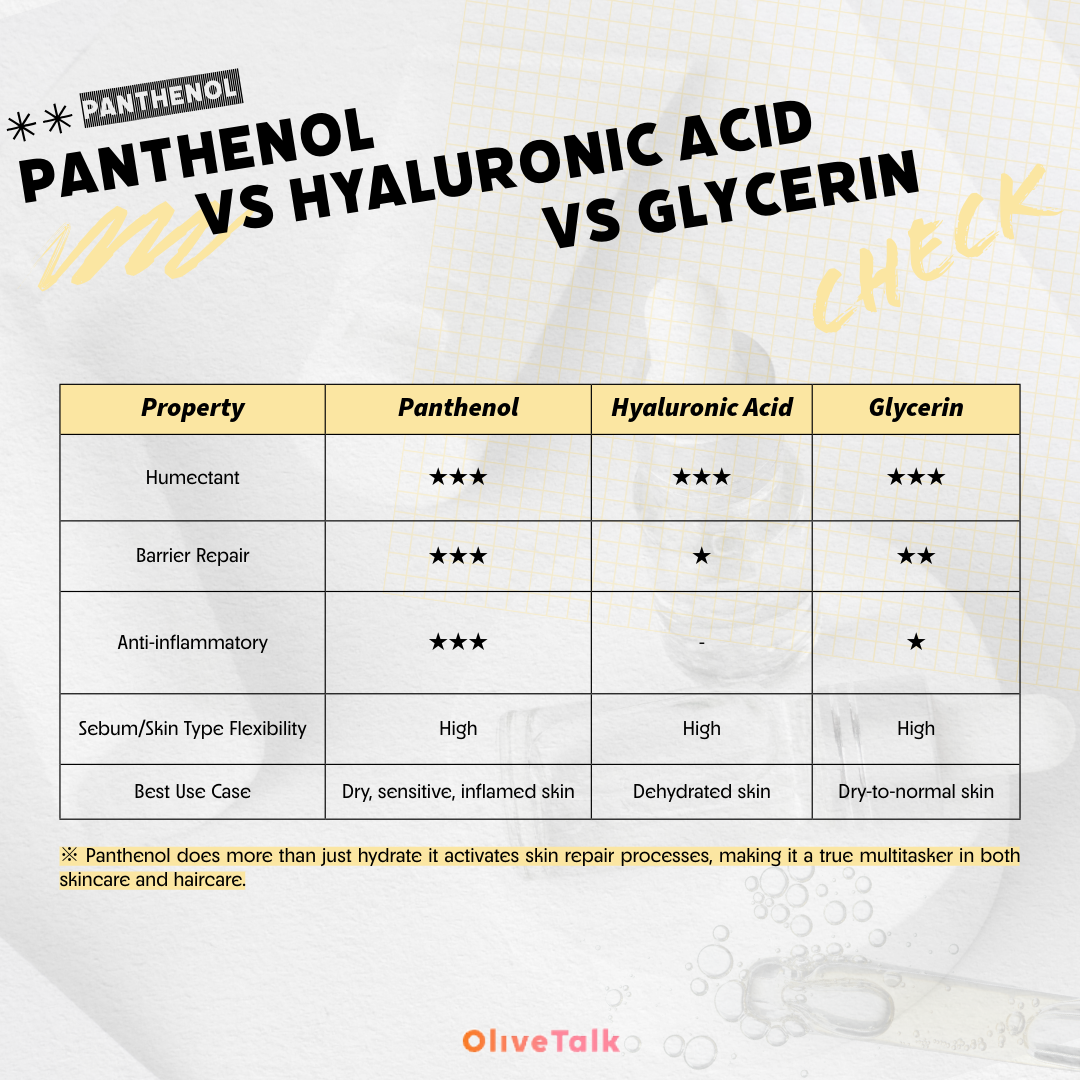
🔍 Panthenol vs. Hyaluronic Acid vs. Glycerin
(Property / Panthenol / Hyaluronic Acid / Glycerin)
Humectant / ✔✔✔ / ✔✔✔ / ✔✔✔
Barrier Repair / ✔✔✔ / ✔ / ✔✔
Anti-inflammatory / ✔✔✔ / ✖ / ✔
Sebum/Skin Type Flexibility / High / High / High
Best Use Case / Dry, sensitive, inflamed skin / Dehydrated skin / Dry-to-normal skin
※ Panthenol does more than just hydrate it activates skin repair processes, making it a true multitasker in both skincare and haircare.
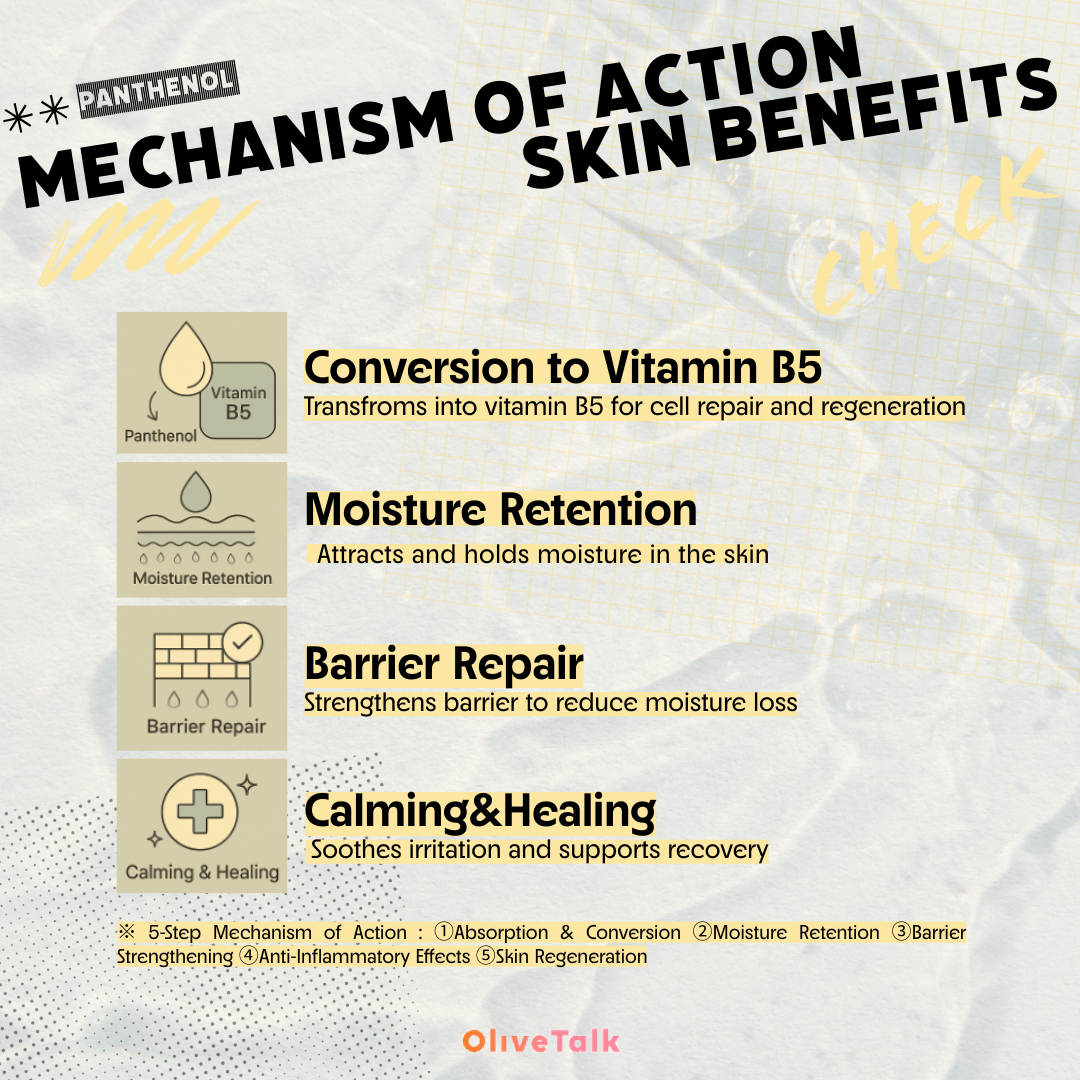
🔬 Mechanism of Action I (Moisture & Barrier Repair)
Upon topical application, panthenol
- Converts into pantothenic acid, a coenzyme for lipid synthesis
- Enhances skin hydration by attracting and locking in water
- Stimulates epidermal cell regeneration and fibroblast proliferation
- Strengthens the intercellular lipid matrix of the stratum corneum
- Reduces transepidermal water loss (TEWL), reinforcing the skin barrier
💡 Mechanism of Action II (Soothing & Skin Healing)
- Reduces redness and itching in irritated skin
- Inhibits pro-inflammatory cytokines (e.g., IL-6, TNF-α)
- Promotes faster wound closure and tissue repair
- Enhances skin elasticity and softness in chronic dry skin
- Excellent for post-laser or retinoid-compromised skin
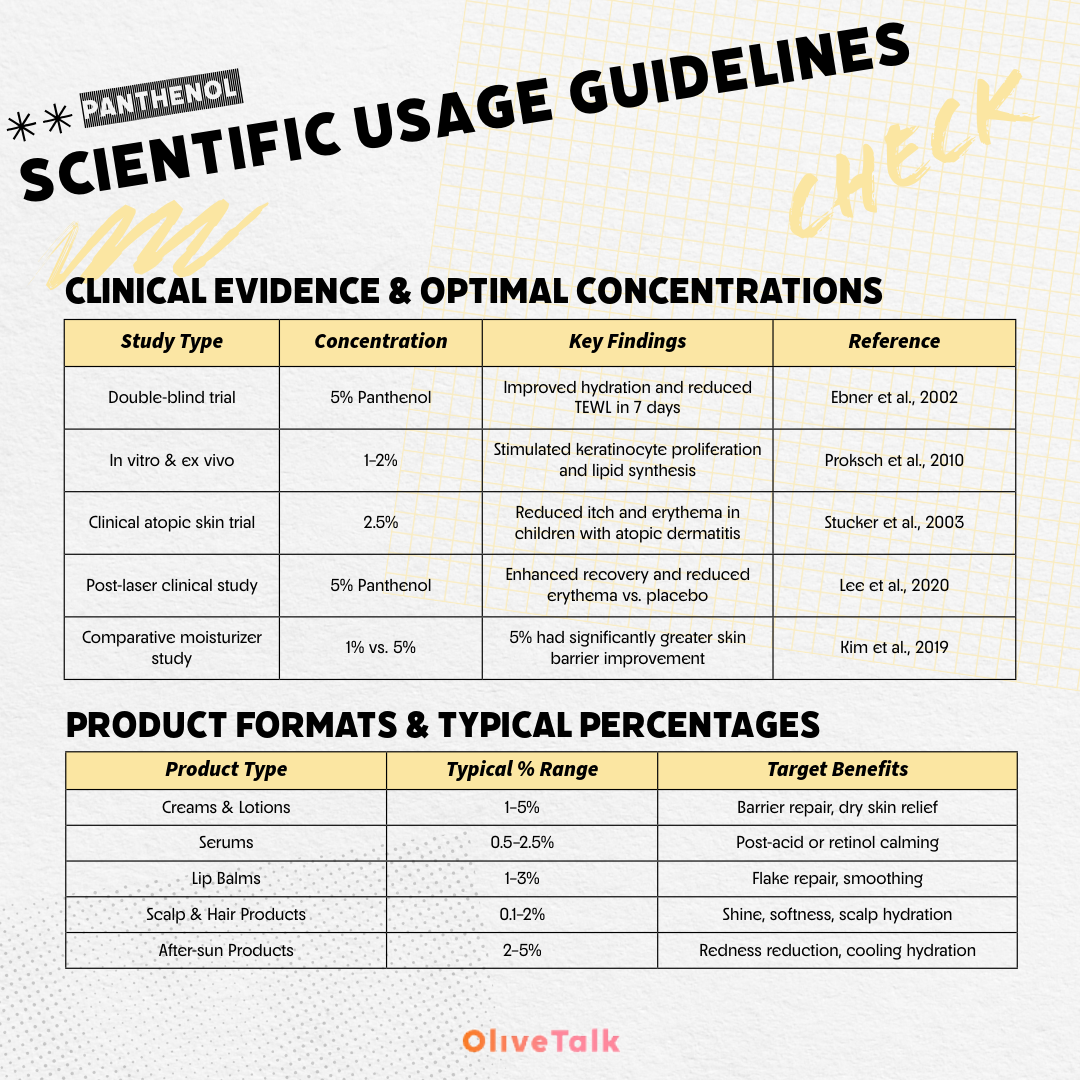
📊 Clinical Evidence & Optimal Concentrations
(Study Type / Concentration / Key Findings / Reference)
- Double-blind trial / 5% Panthenol / Improved hydration and reduced TEWL in 7 days / Ebner et al., 2002
- In vitro & ex vivo / 1–2% / Stimulated keratinocyte proliferation and lipid synthesis / Proksch et al., 2010
- Clinical atopic skin trial / 2.5% / Reduced itch and erythema in children with atopic dermatitis / Stucker et al., 2003
- Post-laser clinical study / 5% Panthenol / Enhanced recovery and reduced erythema vs. placebo /
Lee et al., 2020
- Comparative moisturizer study / 1% vs. 5% / 5% had significantly greater skin barrier improvement / Kim et al., 2019
※ Recommended Use Range
- 0.5–2%: Daily hydration and calming
- 2.5–5%: Clinical-level barrier repair, post-treatment recovery
- Up to 10%: In medical formulations (e.g., burn ointments)
🧴 Product Formats & Typical Percentages
(Product Type / Typical % Range / Target Benefits)
- Creams & Lotions / 1–5% / Barrier repair, dry skin relief
- Serums / 0.5–2.5% / Post-acid or retinol calming
- Lip Balms / 1–3% / Flake repair, smoothing
- Scalp & Hair Products / 0.1–2% / Shine, softness, scalp hydration
- After-sun Products / 2–5% / Redness reduction, cooling hydration
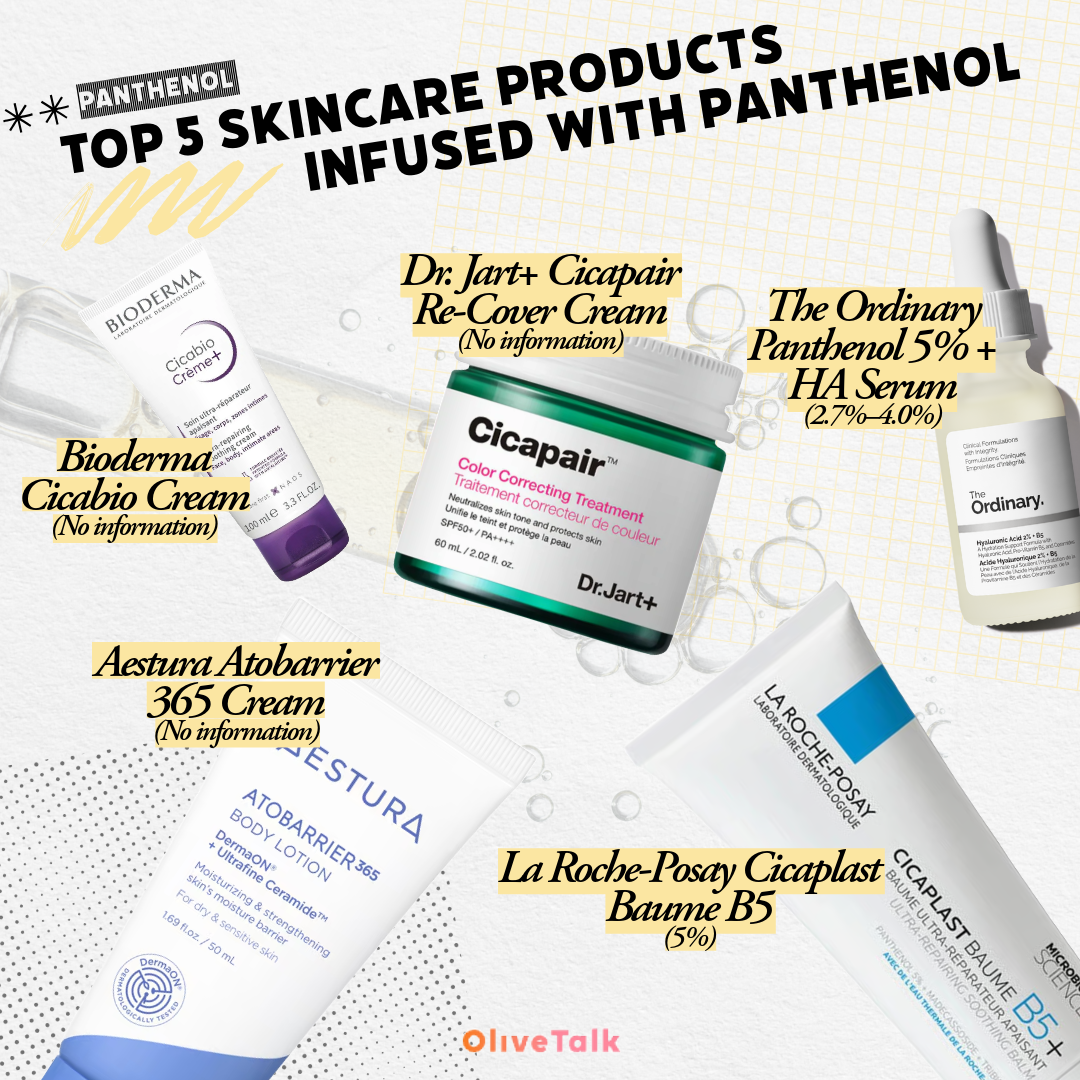
<Top 5 Skincare Products Infused with Panthenol>
1. La Roche-Posay Cicaplast Baume B5
Panthenol Content : 5%
Country : FR
2. Dr. Jart+ Cicapair Re-Cover Cream
Panthenol Content : No information
Country : KR
3. Aestura Atobarrier 365 Cream
Panthenol Content : No information
Country : KR
4. Bioderma Cicabio Cream
Panthenol Content : No information
Country : FR
5. The Ordinary Hyaluronic Acid 2% + B5 Serum
Panthenol Content : 2.7%–4.0%
Country : CA
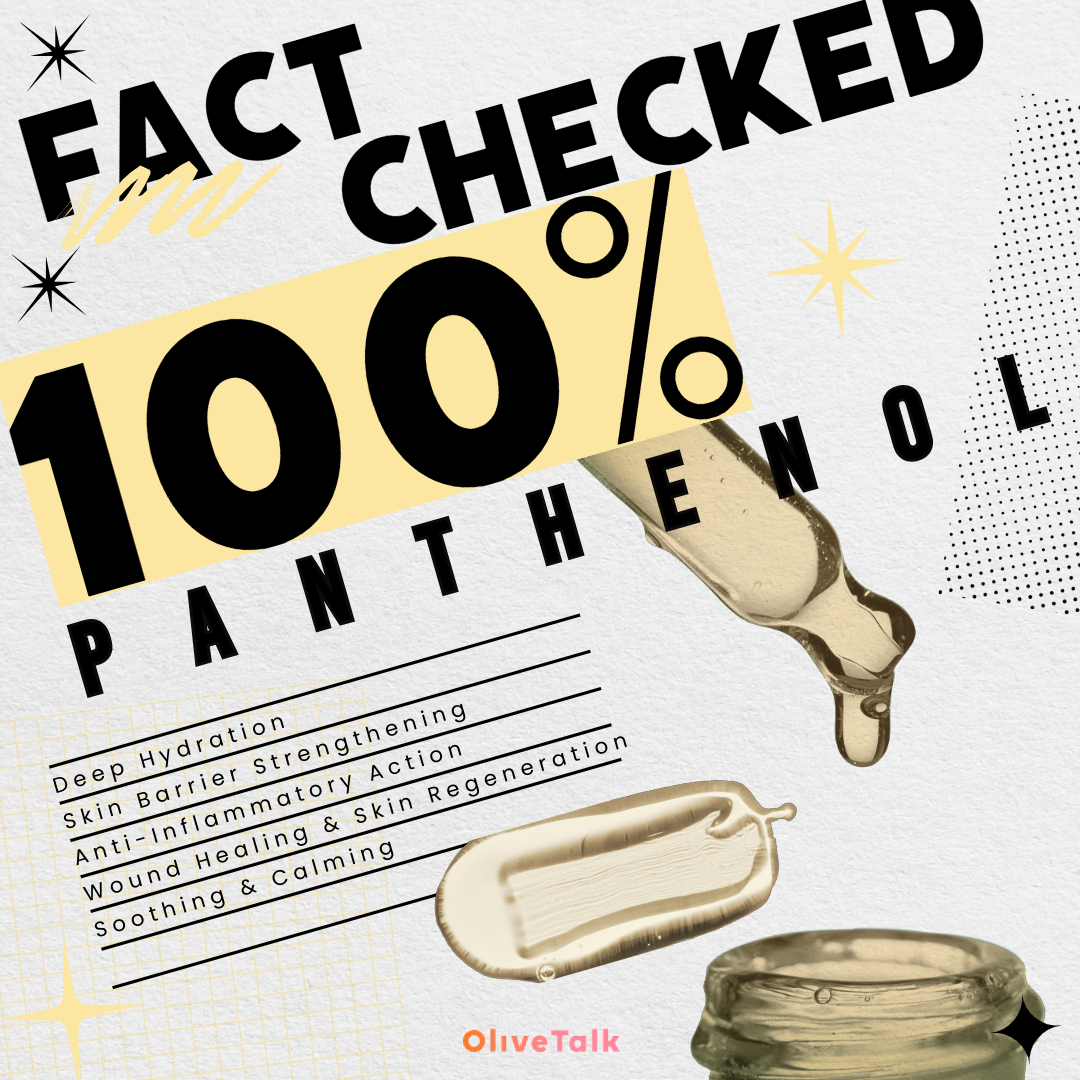
🏛️ Historical Note: From Wound Clinics to Daily Moisturizers
Panthenol’s history is grounded in medical dermatology used for treating burns, abrasions, and eczema. Its gentleness and regenerative power led to wide adoption in infant skincare, post-procedure care, and even tattoo healing. Today, it’s a benchmark ingredient in barrier-supportive beauty.
💾 Final Thoughts from a Skincare Expert
Panthenol is one of the most underrated actives in modern skincare. It doesn’t chase trends it builds resilience. If your skin is inflamed, overexfoliated, reactive, or simply dry, panthenol doesn’t just soothe it — it teaches it how to heal.
Think of it as first aid in a bottle but for your face.
📚 References
Ebner, F. et al. (2002). Topical use of dexpanthenol in skin disorders. American Journal of Clinical Dermatology, 3(6), 427–433.
Proksch, E. et al. (2010). Dexpanthenol in skin disorders: Biochemical and clinical evaluation. Skin Pharmacology and Physiology, 23(3), 141–147.
Stucker, M. et al. (2003). Efficacy of dexpanthenol in atopic dermatitis. Pediatric Dermatology, 20(4), 308–312.
Lee, D. H. et al. (2020). Clinical recovery of skin barrier after laser resurfacing with panthenol-based cream. Dermatologic Surgery, 46(6), 765–772.
Kim, M. J. et al. (2019). A comparison of moisturizing efficacy between 1% and 5% panthenol. International Journal of Cosmetic Science, 41(4), 378–385.
Gehring, W. (2004). Moisturizers and emollients. Clinics in Dermatology, 22(6), 607–612.
Baumann, L. (2009). Skin aging and barrier repair: Role of panthenol. Journal of Clinical and Aesthetic Dermatology, 2(4), 38–40.
Otberg, N. et al. (2007). Panthenol: The pharmacological and cosmetic rationale. Drugs of Today, 43(8), 539–546.
 50Comments
50Comments-
 Influencer22 days agoWow this was like reading a mini thesis...but actually digestible
Influencer22 days agoWow this was like reading a mini thesis...but actually digestible -
 Influencer22 days agois there any risk of overusing panthenol in daily routines? Like, can it cause congestion or interfere with actives?
Influencer22 days agois there any risk of overusing panthenol in daily routines? Like, can it cause congestion or interfere with actives? Influencer22 days agoGreat Q! I use 5% panthenol cream with tret and I’ve never had issues, but maybe it depends on the formulation? I’d love to see this discussed too
Influencer22 days agoGreat Q! I use 5% panthenol cream with tret and I’ve never had issues, but maybe it depends on the formulation? I’d love to see this discussed too -
 Influencer22 days agoPanthenol is my safety net. I stripped my skin barrier with too many actives last winter and a 5% cream legit brought me back to life. This ingredient is why I now only use 3 products max!
Influencer22 days agoPanthenol is my safety net. I stripped my skin barrier with too many actives last winter and a 5% cream legit brought me back to life. This ingredient is why I now only use 3 products max! Influencer22 days agoGlad your skin got recovered! Which panthenol-product have you been using tho?
Influencer22 days agoGlad your skin got recovered! Which panthenol-product have you been using tho? Influencer21 days agoSame here. I cut down my routine to cleanser + panthenol cream + sunscreen and my skin’s never been calmer. Less really is more sometimes
Influencer21 days agoSame here. I cut down my routine to cleanser + panthenol cream + sunscreen and my skin’s never been calmer. Less really is more sometimes -
 Influencer22 days agoThis is super informative but I’m a little skeptical about the 'teaches your skin to heal' bit. Isn’t that a stretch?
Influencer22 days agoThis is super informative but I’m a little skeptical about the 'teaches your skin to heal' bit. Isn’t that a stretch? Influencer21 days agoI interpreted it more metaphorically, like giving your skin the resources to function optimally. But fair point, it’d be cool to see more discussion on the biochemical side!
Influencer21 days agoI interpreted it more metaphorically, like giving your skin the resources to function optimally. But fair point, it’d be cool to see more discussion on the biochemical side! -
 Influencer22 days agoHonestly, panthenol deserves the same hype niacinamide gets
Influencer22 days agoHonestly, panthenol deserves the same hype niacinamide gets Influencer22 days agoYessss this. It’s one of those ingredients I never need to worry about when layering. A quiet MVP.
Influencer22 days agoYessss this. It’s one of those ingredients I never need to worry about when layering. A quiet MVP. Influencer21 days agoLiterally tho!! The way it supports ceramide production and boosts elasticity while being so low-risk?? It’s barrier-care royalty
Influencer21 days agoLiterally tho!! The way it supports ceramide production and boosts elasticity while being so low-risk?? It’s barrier-care royalty -
 Influencer22 days agoI'd love to make a routine for active-days so I'm curious which other actives would get along with panthenol.
Influencer22 days agoI'd love to make a routine for active-days so I'm curious which other actives would get along with panthenol. -
 Influencer22 days agoMy OG, La Roche-Posay Cicaplast!!! I've been with this for years and it's this cream that always saves me from breakout-traps.
Influencer22 days agoMy OG, La Roche-Posay Cicaplast!!! I've been with this for years and it's this cream that always saves me from breakout-traps. -
 Influencer22 days agoLove the comparison part!! Thx xx
Influencer22 days agoLove the comparison part!! Thx xx -
 Influencer22 days agoHas anyone used Dr. Jart+ Cicapair Re-Cover Cream before? I've tried all of the products above but not this. I'm curious what it is like.
Influencer22 days agoHas anyone used Dr. Jart+ Cicapair Re-Cover Cream before? I've tried all of the products above but not this. I'm curious what it is like. -
 Influencer21 days agoIs it weird that every time I use panthenol creams I get tiny whiteheads? I’m wondering if it’s the ingredient or just the occlusive base they’re usually in…
Influencer21 days agoIs it weird that every time I use panthenol creams I get tiny whiteheads? I’m wondering if it’s the ingredient or just the occlusive base they’re usually in… Influencer21 days agoNot weird at all! Panthenol itself is usually pretty gentle and non-comedogenic, but the formulation matters a lot. Often, the creams with panthenol come in thicker, occlusive bases that can trap oils and sweat, leading to those tiny whiteheads.
Influencer21 days agoNot weird at all! Panthenol itself is usually pretty gentle and non-comedogenic, but the formulation matters a lot. Often, the creams with panthenol come in thicker, occlusive bases that can trap oils and sweat, leading to those tiny whiteheads. Influencer21 days agoIf you want to keep the benefits without the breakouts, try a lightweight serum or gel with panthenol instead less likely to clog pores!
Influencer21 days agoIf you want to keep the benefits without the breakouts, try a lightweight serum or gel with panthenol instead less likely to clog pores! -
 Influencer21 days agoI didn’t even know panthenol was used in hair products until this! No wonder my scalp serum has been so calming lately. It’s kinda wild how versatile this one ingredient is.
Influencer21 days agoI didn’t even know panthenol was used in hair products until this! No wonder my scalp serum has been so calming lately. It’s kinda wild how versatile this one ingredient is. Influencer15 days agoI know right?? Btw which scalp serum are you on??
Influencer15 days agoI know right?? Btw which scalp serum are you on?? Influencer15 days ago@Influencer Not her but mine, Pattern by Tracee Ellis Ross scalp serum has panthenol! And it is super moisturizing!
Influencer15 days ago@Influencer Not her but mine, Pattern by Tracee Ellis Ross scalp serum has panthenol! And it is super moisturizing! -
 Influencer21 days agoOkay but why does no one talk about how nice panthenol feels?? Like not greasy, not tacky, just ✨balanced✨
Influencer21 days agoOkay but why does no one talk about how nice panthenol feels?? Like not greasy, not tacky, just ✨balanced✨ -
 Influencer21 days agoAfter nuking my skin with tretinoin, 5% panthenol was the only hing that stopped the peeling/flaking cycle. That 'teaches skin to heal' line isn't marketing since I literally watched my barrier rebuild in real time. HG for life.
Influencer21 days agoAfter nuking my skin with tretinoin, 5% panthenol was the only hing that stopped the peeling/flaking cycle. That 'teaches skin to heal' line isn't marketing since I literally watched my barrier rebuild in real time. HG for life. -
 Influencer21 days agoBy the way if it's so great, why don't more brands disclose concentrations? side-eyes Dr. Jart We need standardized labeling so we're not just guessing if a product has clinical-level amounts.
Influencer21 days agoBy the way if it's so great, why don't more brands disclose concentrations? side-eyes Dr. Jart We need standardized labeling so we're not just guessing if a product has clinical-level amounts. Influencer15 days agoUgh same 😮💨
Influencer15 days agoUgh same 😮💨 -
 Influencer21 days agoPanthenol and centella are the ultimate calming duo. My rosacea flares disappear within hours when I layer Cicaplast over my medicated creams. More effective than any calming trend I've tried.
Influencer21 days agoPanthenol and centella are the ultimate calming duo. My rosacea flares disappear within hours when I layer Cicaplast over my medicated creams. More effective than any calming trend I've tried. -
 Influencer21 days agoMany diaper rash creams have 5-10% panthenol for under $10. I use them on my face during retinol uglies.
Influencer21 days agoMany diaper rash creams have 5-10% panthenol for under $10. I use them on my face during retinol uglies. Influencer15 days agoUnder $10?? That's crazily cheap!!! I gotta look it up rn
Influencer15 days agoUnder $10?? That's crazily cheap!!! I gotta look it up rn -
 Influencer21 days agoUnlike many actives it sounds like playing nice!!
Influencer21 days agoUnlike many actives it sounds like playing nice!! -
 Influencer20 days agoThis post just saved me from panic-Googling why my skin barrier is wrecked... Bookmarking for life. Panthenol really is the quiet MVP of skincare.
Influencer20 days agoThis post just saved me from panic-Googling why my skin barrier is wrecked... Bookmarking for life. Panthenol really is the quiet MVP of skincare. -
 Influencer20 days agoLove how you broke down the differences between panthenol, ha and glycerin. Always lumped them together as just hydrators.
Influencer20 days agoLove how you broke down the differences between panthenol, ha and glycerin. Always lumped them together as just hydrators. -
 Influencer20 days agoDo you know if the D-panthenol form is clearly listed on product labels? I’ve been using Cicaplast for years but never paid attention to which form it used 😅😅
Influencer20 days agoDo you know if the D-panthenol form is clearly listed on product labels? I’ve been using Cicaplast for years but never paid attention to which form it used 😅😅 Influencer15 days agoGood q 👏
Influencer15 days agoGood q 👏 -
 Influencer20 days agoNow I’m tempted to build a whole routine around panthenol… Do you have any favorite serums with it at 2–5%? Most of mine are creams or balms but I’d love a lightweight option for summer.
Influencer20 days agoNow I’m tempted to build a whole routine around panthenol… Do you have any favorite serums with it at 2–5%? Most of mine are creams or balms but I’d love a lightweight option for summer. -
 Influencer20 days agoCurious why some brands do not show how much glycerin their products have.
Influencer20 days agoCurious why some brands do not show how much glycerin their products have. Influencer14 days agoIt's so frustrating! Glycerin is literally in everything but brands act like it's some big secret. My theory? They don't want us realizing their $50 moisturizer has the same glycerin concentration as the $5 drugstore one.
Influencer14 days agoIt's so frustrating! Glycerin is literally in everything but brands act like it's some big secret. My theory? They don't want us realizing their $50 moisturizer has the same glycerin concentration as the $5 drugstore one. Influencer14 days agoBc then we'd know their hg hydrator is just 5% glycerin with water and hype🙄
Influencer14 days agoBc then we'd know their hg hydrator is just 5% glycerin with water and hype🙄 Influencer14 days ago@Influencer My tip is if it's in the first 5 ingredients but no % given, I assume it's probably carrying the whole product.
Influencer14 days ago@Influencer My tip is if it's in the first 5 ingredients but no % given, I assume it's probably carrying the whole product. -
 Influencer18 days agoAfter nuking my barrier with overzealous exfoliation, La Roche-Posay Cicaplast, which has 5% panthenol, saved me in 3 days flat. Now I side-eye any barrier repair cream that doesn’t disclose its panthenol %.
Influencer18 days agoAfter nuking my barrier with overzealous exfoliation, La Roche-Posay Cicaplast, which has 5% panthenol, saved me in 3 days flat. Now I side-eye any barrier repair cream that doesn’t disclose its panthenol %. -
 Influencer18 days agoThat 2.7-4% panthenol and hyaluronic acid is the only thing that keeps my tret face from peeling. For $10? Unmatched fr.
Influencer18 days agoThat 2.7-4% panthenol and hyaluronic acid is the only thing that keeps my tret face from peeling. For $10? Unmatched fr. -
 Influencer18 days agoAs an eczema sufferer, I stan panthenol’s OG medical roots. The second my derm recommended a 10% panthenol ointment for flare-ups, my skin entered its redemption arc. Drugstore panthenol creams could never.
Influencer18 days agoAs an eczema sufferer, I stan panthenol’s OG medical roots. The second my derm recommended a 10% panthenol ointment for flare-ups, my skin entered its redemption arc. Drugstore panthenol creams could never. Influencer14 days ago10% panthenol literally saves my skin. I keep a tube of the medicated ointment in my fridge for bad flares and the cooling effect and healing power is beyond my expectation.
Influencer14 days ago10% panthenol literally saves my skin. I keep a tube of the medicated ointment in my fridge for bad flares and the cooling effect and healing power is beyond my expectation. Influencer14 days agoMore respect for the OG healers, plz!
Influencer14 days agoMore respect for the OG healers, plz! -
 Influencer18 days agoCicapair’s panthenol ?ing no info is such a red flag. If Aestura and LRP can proudly state their concentrations, why can’t they? Suspicious behavior for a brand that charges $40 for a tiny tube.
Influencer18 days agoCicapair’s panthenol ?ing no info is such a red flag. If Aestura and LRP can proudly state their concentrations, why can’t they? Suspicious behavior for a brand that charges $40 for a tiny tube. -
 Influencer18 days agoIs there anything to be cautious about using panthenol tho?
Influencer18 days agoIs there anything to be cautious about using panthenol tho? Influencer7 days agoCurious too 🤔
Influencer7 days agoCurious too 🤔 Influencer7 days agoGenerally, panthenol is super well-tolerated and loved for its soothing, hydrating, and barrier-supporting properties. It’s in a ton of products for a reason! That said, a small number of people can react to it, either due to the panthenol itself or other ingredients in the formula it’s in. If you have super reactive skin or a history of contact dermatitis, it’s worth patch testing first.
Influencer7 days agoGenerally, panthenol is super well-tolerated and loved for its soothing, hydrating, and barrier-supporting properties. It’s in a ton of products for a reason! That said, a small number of people can react to it, either due to the panthenol itself or other ingredients in the formula it’s in. If you have super reactive skin or a history of contact dermatitis, it’s worth patch testing first. Influencer7 days ago@Influencer Also, in rare cases, products with high concentrations of panthenol might feel a bit sticky or heavy, especially if layered with other occlusives.
Influencer7 days ago@Influencer Also, in rare cases, products with high concentrations of panthenol might feel a bit sticky or heavy, especially if layered with other occlusives. Influencer7 days agoFor most ppl, panthenol is super safe and soothing so there is not much to worry about! Just patch test if you have sensitive skin, and watch out for stickiness if it’s in high amounts!!
Influencer7 days agoFor most ppl, panthenol is super safe and soothing so there is not much to worry about! Just patch test if you have sensitive skin, and watch out for stickiness if it’s in high amounts!! Influencer7 days ago@Influencer Other than the stickiness, nothing to worry abt it? I heard high amount of humectants may cause irritation.
Influencer7 days ago@Influencer Other than the stickiness, nothing to worry abt it? I heard high amount of humectants may cause irritation.